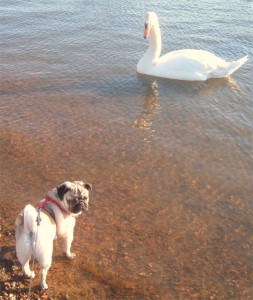Good day and welcome everyone!
This is Sharda with another Pugs newsletter.
Today we will have a closer look at Pug Characteristics and traits unique for this breed.
Here we go!
When the British called the first Pugs in their country “Dutch Mastiffs,” surely they were complimenting these medium-sized but substantial dogs.
The breed standard describes the Pug as multum in parvo or “much in a small package”-perhaps the right name for this sturdy but compact, muscular, well balanced dog.
However, a plump Pug is as undesirable as a scrawny one.
In the U.S, Pugs are classified as a Toy breed, and in this category, they are the largest. At a weight ranging between 6-8 kg, they are very sturdy. This dog’s most distinctive features are its head and tail.
Its muzzle is foreshortened but happily, it is not laid back as in the Bulldog or Brussels Griffon.
Its heavy face is laden with wrinkles, giving him an air of great wisdom or sorrow. While his skull lies flat between his ears and looks square from the front, his jaw is strong.
His ears, you will find, flop and fold over with their tips brushing the sides of his face.
Overall, his skin is loose and wrinkle-free, except on his head. He has a short double coat with a fine undercoat and a glossy outer coat. You can find Pugs in either black, silver fawn or an apricot fawn.
Though the silver fawn is really a clear fawn or grayish silver the apricot fawn ranges from cream to deep apricot. However, both have a black mask, black ears and a fine black line or trace from the back of the skull occipital to the tail.
If you find that your Pug bears a black diamond on his forehead or a black mole on his cheek, don’t worry because this conforms to the standard, though his muddy colour may not. This blurring of colours may be due to breeding black Pugs with fawn-coloured ones—something only irresponsible breeders could do.
Does your Pug dog appear strong with tough muscles, straight legs and top line, matched by a determined gait and a hint of a roll? Well, then you’ve got a typical Pug. If his tail curls tightly over his hip, this is yet another indication you’ve got the right Pug.
The body of your Pug, you will notice, is quite similar to that of a Bulldog, except in size. With a square overall look, the height from the floor to the top of the withers should ideally be equal to the length from the breastbone to the rump.
Physical characteristics of the Pugs: Known as the Himalayan of the Dog world, you should expect your Pug to live 12-14 years. Be careful of his dietary habits, because if you indulge him, he will be very happy to overeat. Ideally, he should weigh not more than 6.3-8 kg and should be seen only in recognized coat colours such as silver, apricot fawn and black.
Pug temperament: Temperamentally too, you will find that he is indeed a family dog. A stable and even-tempered dog, he is playful and an extrovert, a big hit with your children and with adults without children. He is low on activity and maintenance, and just right for life in an apartment or condo. He is equally comfortable in small towns and large cities and is ideal for the elderly or the disabled.
He is playful, mischievous, intelligent and affectionate and gets along well with family and other pets. He loves any attention, especially if it comes from children, but be careful with very young children. He is loyal to his owner and family members and will warn them against strangers.
The Pug is a veritable companion dog that loves others and must be loved in return. This is why, being people-centric, he is cherished as a companion dog. He demands human companionship and needs it for his emotional survival.
The flip side of this is that he cannot be left alone for long stretches of time, but you can alleviate this problem if you have an animal companion for him, perhaps another Pug too.
Your Pug is an outdoorsy pet who loves playing and going for walks. As an owner of a Pug, you will need to take care that he is not harmed, since he isn’t too big.
The Pug is also quite trainable, if you’re patient and persistent. But having said that, doesn’t make the mistake of yelling at him during the training session, and don’t hit him either because he, like most dog breeds, will respond best to positive reinforcement.
So, praise him every time he does something well, such as having a pee outside of your house. You will find that he is also very eager to please you and will shine with pride if you praise him often.
Health problems: For all his positive traits, he has a tendency to several genetic disorders such as encephalitis, mange and dry eyes and, due to his bulging eyes he may also suffer from a range of eye injuries.
The structure of his skull also poses breathing difficulties and therefore it is necessary that you keep him away from very hot environments.
I hope that you learned a lot from today’s Pugs newsletter
All the best and take care
Warmly,
Sharda Baker

